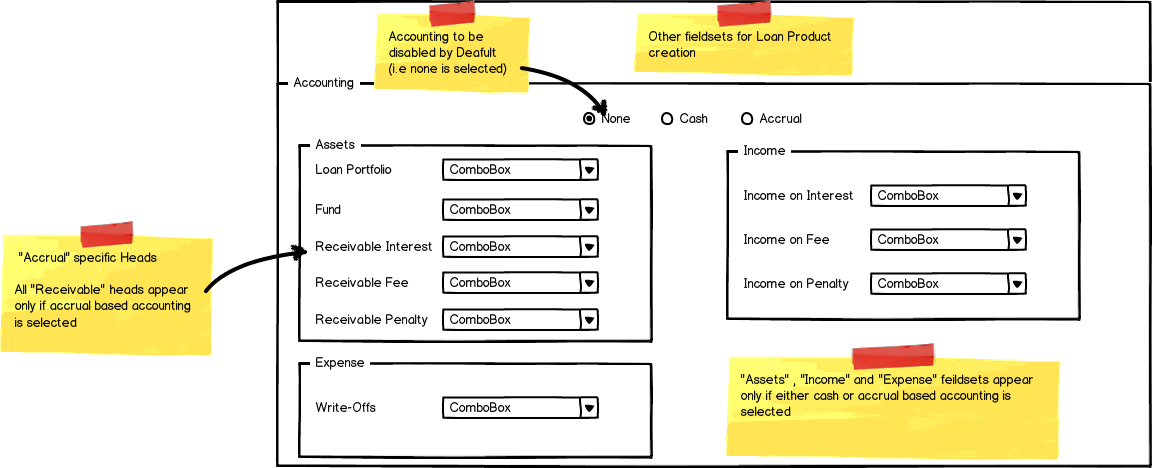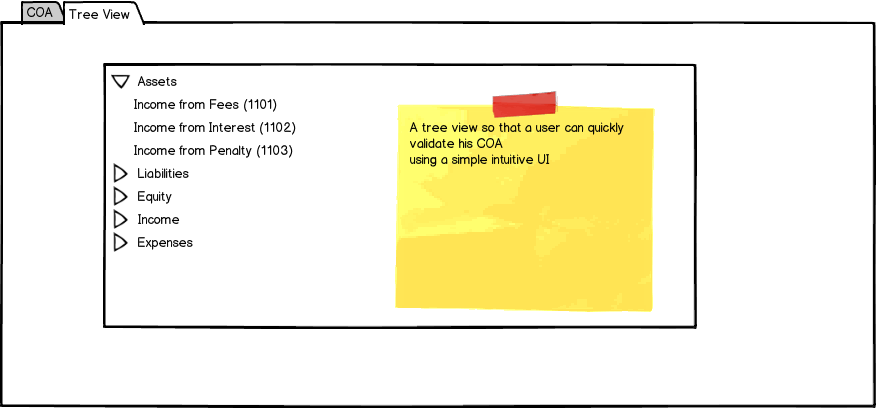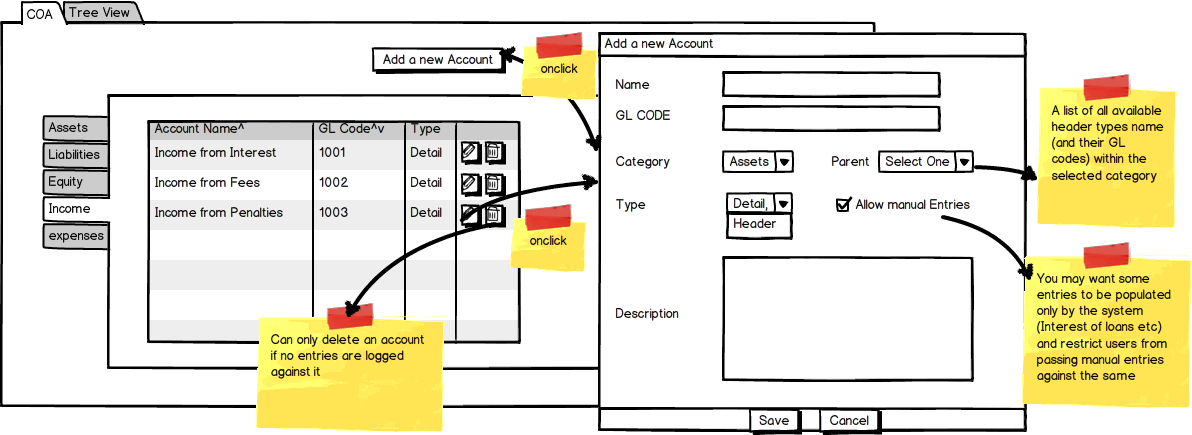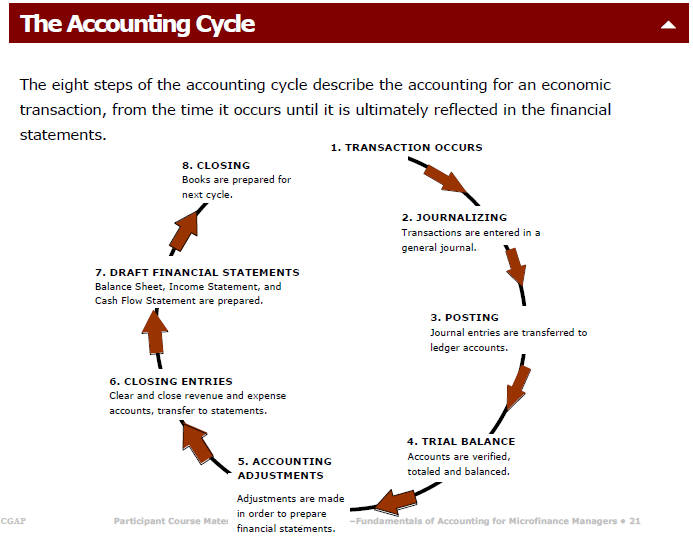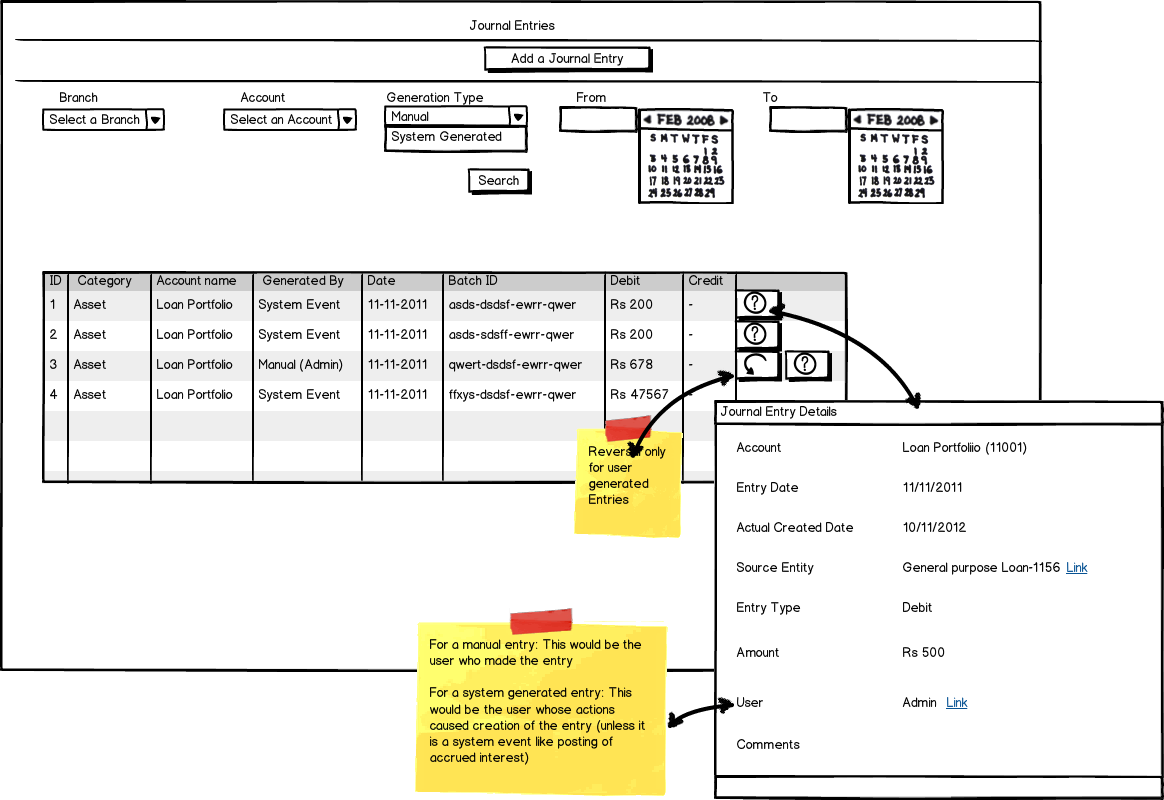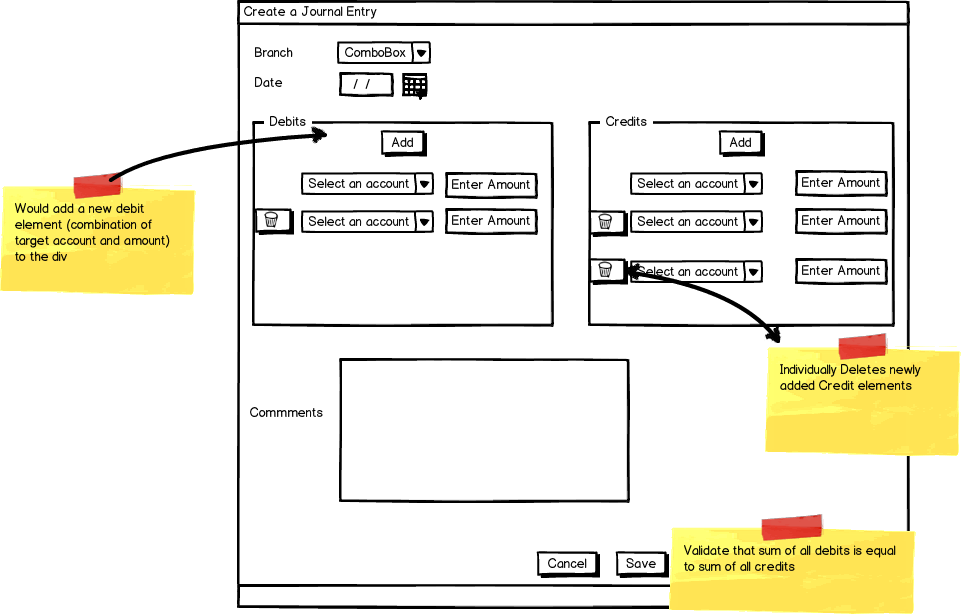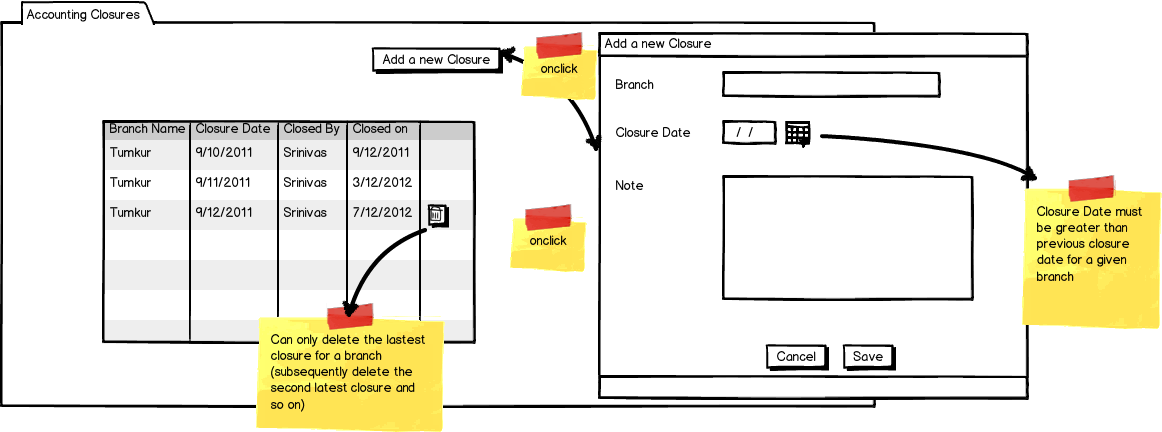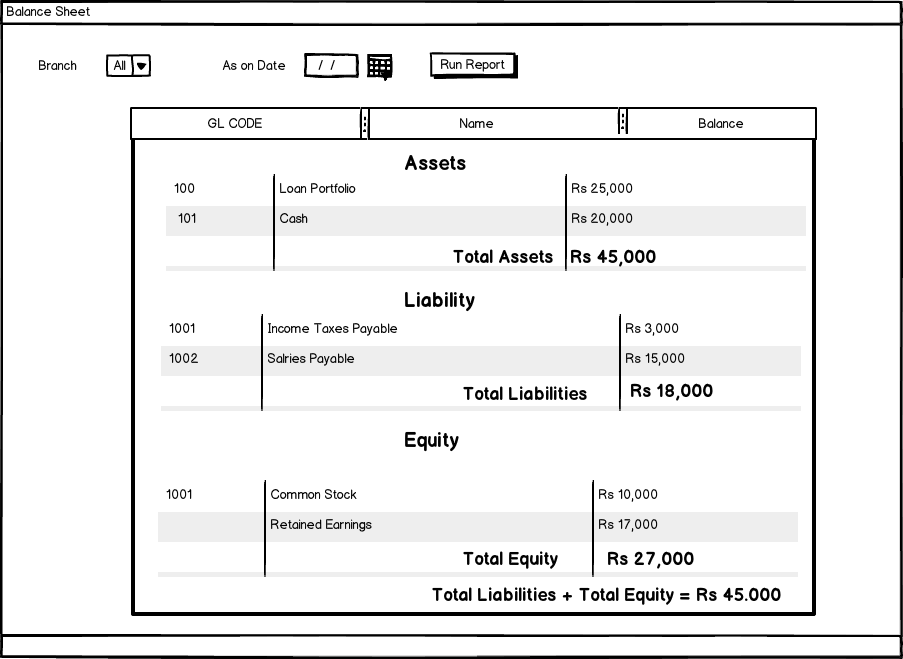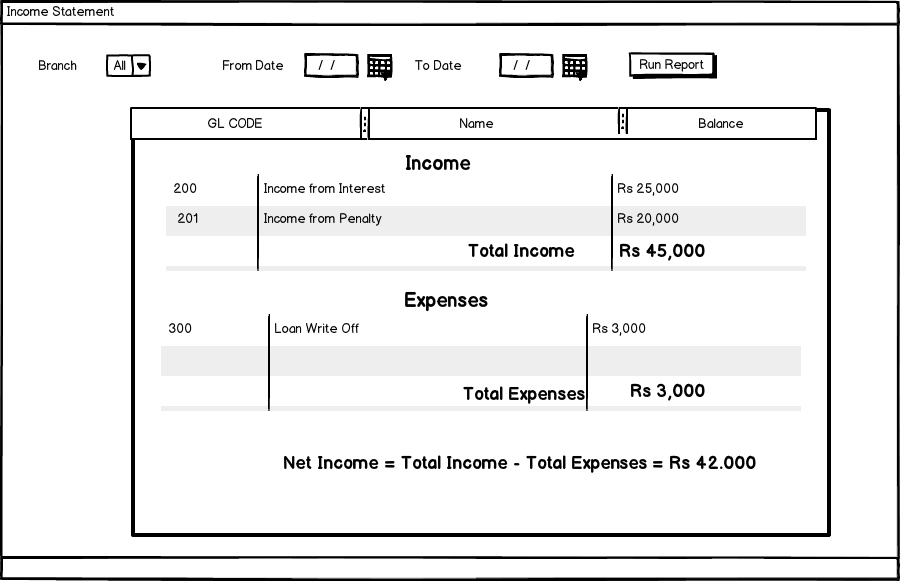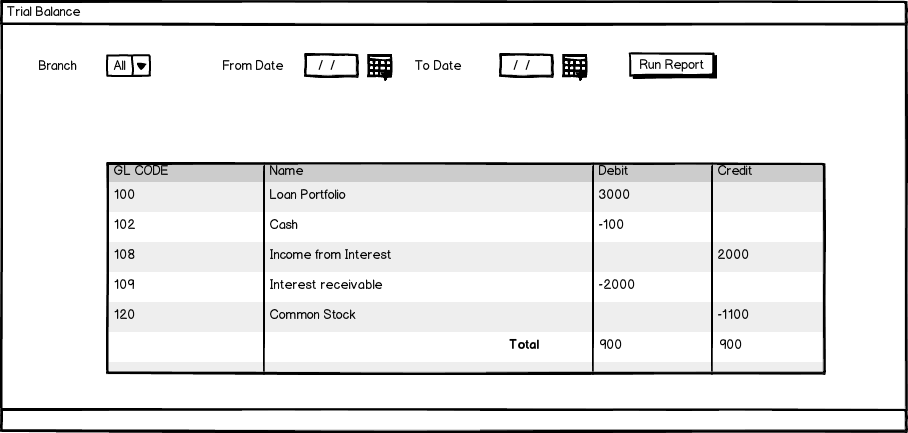A Possible accounting Spec
Accounting Module Functionality and Expectations
1 What Accounting rules?
User must be able to select the applicable accounting rule as "none", "cash" or "accrual" at a product level.
The user is expected at the time of product definition to select the “type” of accounting for the product and select his appropriate General Ledger (GL) “Detail account” for the placeholders Mifos X accounting module provides
Page 10 of attached accounting summary document gives useful basic distinction between cash and accrual accounting.
2 The COA
Continue having the same design with five main account "Types":
- Assets
- Liabilities
- Income
- Expenditure
- Equity
Allow adding new accounts of any one of these types from the UI.
New accounts can be either "header" or "detail" accounts to make things simpler for a user. "Header" accounts would be used purely for grouping together
related accounts etc. An organization would not log journal entries against the same (Journal entry screens would not list "Header" accounts).
Question: Would you be interested in hearing what COA nirantara and GK accountants use (or any other MFI in community)? On document pages 23, 24 is content about the 'classification of transactions' through chart of accounts and a sample chart of accounts for MFIs. How does nirantara and gk COA differ and why would be good to know.
2.1 Scope
For simplicity (for the first cut) have COA at organization level and run accounting reports at the branch level
- So system should associate all journal entries to branch which owns the entity that caused the entry (Example: Loan account on which a disbursal occurred)
- All user defined journal entries should also be associated with a branch
3 Journal Entries
The 'accounting cycle' image provided on page 22 of attached accounting summary document provides a good visualization of steps involved from 'economic activity step (transaction)' to closing books for a given cycle period (weekly/monthly/quarterly/yearly)
The Journal entries view would look similar to the below mock up
3.1 Automated Journal Entries
Mifos X to automatically log (log each transaction as a separate journal entry....no need of daily consolidation etc.)
- Disbursals
- Repayments
- Rescheduling
- Write-Off
- Adjustments
These journal entries should not have permissions to be altered from the accounting UI (like manually created journal entries which can be reversed etc.)
They should link back to the entity that generated them (the loan transaction etc. so that a user can analyse the same).
They may only be altered with events generating from the system (Example: a user reverts a loan disbursal etc.)
3.2 Manual Journal Entries
For a manual entry, allow "m" debit and "n" credit entries for a "Journal Entry entered by a user" as long as the sums of all debits and credits match.
Allow journal entry reversal (system automatically logs reversal entries of corresponding debits and credits).
This means each journal entry batch must have a batch Id (so all individual entries under it can be identified for easy reversal).
4 Accounting rules for Loans
4.1 Cash based accounting Scenario:
4.1.1 COA Snippet
HEAD | Placeholder |
Assets | Cash |
| Loan Portfolio | |
| Transfers in Suspense | |
Income | Interest on loans |
Income from fees | |
Income from Penalties | |
Expenses | Losses Written Off |
| Liability | Loan Over-payments |
4.1.2 Posting Rules
Event | Debit | Credit |
Disbursal | Loan Portfolio | Cash |
Principal repayment | Cash | Loan Portfolio |
Interest repayment | Cash | Interest on loans |
Principal Write off | Losses Written Off | Loan Portfolio |
Fees payment | Cash | Income from fees |
Penalty payment | Cash | Income from Penalties |
| Initiate Transfer (From Branch A to Branch B) | Transfers in Suspense | Loan Portfolio |
| Accept Transfer (In Branch B) | Loan Portfolio | Transfers in Suspense |
| Over payment | Cash | Loan Over-payments |
| Refund (of Overpaid amount) | Loan Over-payments | Cash |
4.2 Accrual Based accounting Scenario
Would only involve posting to three new accounts (Receivables "Income Type").
4.2.1 COA Snippet
HEAD | Placeholder |
Assets | Cash |
Loan Portfolio | |
Receivables Interest | |
Receivables Fees | |
Receivables Penalties | |
INCOME | Interest on loans |
Income from fees | |
Income from Penalties | |
Expenses | Losses Written Off |
4.2.2 Posting Rules
Event | Debit | Credit |
Disbursal | Loan Portfolio | Cash |
Interest Applied | Receivables Interest | Interest on loans |
Fee Applied | Receivables fee | Income from fees |
Penalty Applied | Receivables penalties | Income from Penalties |
Principal repayment | Cash | Loan Portfolio |
Interest repayment | Cash | Receivables Interest |
Principal Write off | Losses Written Off | Loan Portfolio |
Fees payment | Cash | Receivables fee |
Penalty payment | Cash | Receivables penalties |
Interest write off | Losses Written Off | Receivables Interest |
Fee write off | Losses Written Off | Receivables fee |
Penalty write off | Losses Written Off | Receivables penalties |
4.2.3 Examples
4.2.3.1 Flat Interest Type
When Interest Type is flat, prepayment does not write off any interest. The entire interest is recognized and “receivable” as soon as the loan is disbursed.
The entire interest (for complete duration of the loan) is recognized immediately after disbursal.
There are quite a few conflicting views on if this special treatment is required. However, leaving it in here for now till we get feedback from a few accountants.
The sample loan shown here follows a monthly repayment cycle.
Event | Debit | Credit |
Disbursal (7-10-2012) | Portfolio Control Account (1) | Fund (1) |
Interest Receivable (2) | Income from interest (2) | |
Apply Fee (7-10-2012) | Fees Receivable(3) | Income from fees (3) |
Principal, Interest and Fee Repayment(1) (7-11-2012) | Fund (4) | Interest Receivable (4) |
Portfolio Control Account (4) | ||
Fees Receivable(4) | ||
Prepayment for next n-1 Installments (excluding part of last principal) (8-11-2012) | Fund (5) | Interest Receivable (5) |
Portfolio Control Account(5) | ||
Prepayment of remaining Principal (17-11-2012) | Fund (6) | Portfolio Control Account(6) |
*Note: A Batch Id is shown in Brackets
4.2.3.1 Declining Interest Type
In the case of Declining Balance, we have loans involving interest recalculation. The interest is accrued at the date of each repayment.
The system needs to have a job for posting the same
Event | Debit | Credit |
Disbursal (7-10-2012) | Portfolio Control Account (1) | Fund (1) |
Automated System Event (when an Interest repayment becomes due) (7-11-2012) | Interest Receivable (2) | Income from interest (2) |
Principal, Interest Repayment(1st Installment) (7-11-2012) | Fund (3) | Interest Receivable (3) |
Portfolio Control Account (3) | ||
Prepayment for remaining Installment’s (no interest accrued) (7-11-2012) | Fund (4) | Portfolio Control Account(4) |
Note: If any interest is accrued till date while doing a prepayment, the application should automatically log a system generated journal entry
for recognizing the same while doing a prepayment.
4.2.4 Month end and year End Closing
We should also have an option for Month end closing and year end closing at a branch level (basically a bulk “apply accrued interest” till date job for all loans of declining Interest type)
This is must for regulatory requirements. We should have the option of turning the same “on” and “off” from the user interface
*This section needs to be revisited in detail
5 Accounting rules for Savings
5.1 COA Snippet
HEAD | Placeholder |
Assets | Cash |
Income | Income from fees |
Income from Penalties | |
Expenses | Interest for Savings |
| Liability | Savings Control |
| Transfers in Suspense |
5.2 Posting Rules
Event | Debit | Credit |
Deposit | Cash | Savings Control |
Withdrawal | Savings Control | Cash |
Interest posting | Interest for Savings | Savings Control |
Fees payment | Savings Control | Income from fees |
Penalty payment | Savings Control | Income from Penalties |
| Initiate Transfer (From Branch A to Branch B) | Savings Control | Transfers in Suspense |
| Accept Transfer (In Branch B) | Transfers in Suspense | Savings Control |
6 Closure Dates
Allow setting closure dates at branch level after which accounting transactions cannot be posted.
7 Reports
The three basic reports
- Balance sheet
- Profit and Loss Statement
- Trial balance
Some context for reporting
“Golden” rules of accounting:
- Real account: Debit what comes in and credit what goes out.
- Personal account: Debit who receives and Credit who gives.
- Nominal account: Debit all expenses & losses and Credit all incomes and gains
Debit | Credit | |
|---|---|---|
Asset | Increase | Decrease |
Liability | Decrease | Increase |
Equity | Decrease | Increase |
Income | Decrease | Increase |
Expenditure | Increase | Decrease |
7.1 Balance Sheet
A balance sheet summarizes an organization or individual's assets, equity and liabilities at a specific point in time.
Formula : Assets = Liabilities + Equity
7.1.1 Sample Query
The below query is for assets, the queries for liabilities and equity would be same but for the calculation of balance (would be credit - debit refer verbiage in section 6)
select debits.glcode as 'glcode', debits.name as 'name', (ifnull(debits.debitamount,0)-ifnull(credits.creditamount,0)) as 'balance'
from
(select acc_coa.gl_code as 'glcode',name,sum(amount) as 'debitamount'
from acc_journal_entry,acc_coa
where acc_coa.id = acc_journal_entry.coa_id
and acc_journal_entry.type='DEBIT'
and acc_coa.category in ('ASSET')
group by name
order by glcode) debits
LEFT OUTER JOIN
(select acc_coa.gl_code,name,sum(amount) as 'creditamount'
from acc_journal_entry,acc_coa
where acc_coa.id = acc_journal_entry.coa_id
and acc_journal_entry.type='CREDIT'
and acc_coa.category in ('ASSET')
group by name) credits
on debits.name=credits.name
union
select credits.glcode as 'glcode', credits.name as 'name', (ifnull(debits.debitamount,0)-ifnull(credits.creditamount,0)) as 'balance'
from
(select acc_coa.gl_code as 'glcode',name,sum(amount) as 'debitamount'
from acc_journal_entry,acc_coa
where acc_coa.id = acc_journal_entry.coa_id
and acc_journal_entry.type='DEBIT'
and acc_coa.category in ('ASSET')
group by name
order by glcode) debits
RIGHT OUTER JOIN
(select acc_coa.gl_code as 'glcode',name,sum(amount) as 'creditamount'
from acc_journal_entry,acc_coa
where acc_coa.id = acc_journal_entry.coa_id
and acc_journal_entry.type='CREDIT'
and acc_coa.category in ('ASSET')
group by name
order by glcode) credits
on debits.name=credits.name;
7.2 Income Statement (P & L statement)
Income Statement is a company's financial statement that indicates how the revenue (money received from the sale of products and services before expenses are taken out) is transformed into the net income (the result after all revenues and expenses have been accounted for, also known as Net Profit ).
It displays the revenues recognized for a specific period, and the cost and expenses charged against these revenues.
Formula: Net Income = Total Income – Total Expenses
7.2.1 Sample Query
Below query is for Income, the query for expenses would be similar (save for calculation of balance, refer verbiage in section 6)
select *
from
(
select debits.glcode as 'glcode', debits.name as 'name', (ifnull(credits.creditamount,0)-ifnull(debits.debitamount,0)) as 'balance'
from
(select acc_coa.gl_code as 'glcode',name,sum(amount) as 'debitamount'
from acc_journal_entry,acc_coa
where acc_coa.id = acc_journal_entry.coa_id
and acc_journal_entry.type='DEBIT'
and acc_coa.category in ('INCOME')
and acc_journal_entry.entry_date between '2012-11-01' and '2012-11-31'
group by name
order by glcode) debits
LEFT OUTER JOIN
(select acc_coa.gl_code,name,sum(amount) as 'creditamount'
from acc_journal_entry,acc_coa
where acc_coa.id = acc_journal_entry.coa_id
and acc_journal_entry.type='CREDIT'
and acc_coa.category in ('INCOME')
and acc_journal_entry.entry_date between '2012-11-01' and '2012-11-31'
group by name) credits
on debits.name=credits.name
union
select credits.glcode as 'glcode', credits.name as 'name', (ifnull(credits.creditamount,0)-ifnull(debits.debitamount,0)) as 'balance'
from
(select acc_coa.gl_code as 'glcode',name,sum(amount) as 'debitamount'
from acc_journal_entry,acc_coa
where acc_coa.id = acc_journal_entry.coa_id
and acc_journal_entry.type='DEBIT'
and acc_coa.category in ('INCOME')
and acc_journal_entry.entry_date between '2012-11-01' and '2012-11-31'
group by name
order by glcode) debits
RIGHT OUTER JOIN
(select acc_coa.gl_code,name,sum(amount) as 'creditamount'
from acc_journal_entry,acc_coa
where acc_coa.id = acc_journal_entry.coa_id
and acc_journal_entry.type='CREDIT'
and acc_coa.category in ('INCOME')
and acc_journal_entry.entry_date between '2012-11-01' and '2012-11-31'
group by name
order by glcode) credits
on debits.name=credits.name)as fullouterjoinresult
order by glcode;
7.3 Trial Balance
A trial balance is a list of all the General ledger accounts (both revenue and capital) contained in the ledger of a business.
This list will contain the name of the nominal ledger account and the value of that nominal ledger account.The value of the nominal ledger will hold either a debit balance value or a credit balance value.
The debit balance values will be listed in the debit column of the trial balance and the credit value balance will be listed in the credit column.
7.3.1 Sample Query
This is the complete query for the report
select *
from
(select debits.glcode as 'glcode', debits.name as 'name',IF(debits.type = 'ASSET' or debits.type = 'EXPENSES', ifnull(debits.debitamount,0)-ifnull(credits.creditamount,0),'') as 'debit', IF(debits.type = 'INCOME' or debits.type = 'EQUITY' or debits.type = 'LIABILITIES', ifnull(credits.creditamount,0)-ifnull(debits.debitamount,0),'') as 'credit'
from
(select acc_coa.gl_code as 'glcode',name,sum(amount) as 'debitamount',acc_coa.type as 'type'
from acc_journal_entry,acc_coa
where acc_coa.id = acc_journal_entry.coa_id
and acc_journal_entry.type='DEBIT'
and acc_journal_entry.entry_date between '2012-11-01' and '2012-11-31'
group by name
order by glcode) debits
LEFT OUTER JOIN
(select acc_coa.gl_code,name,sum(amount) as 'creditamount',acc_coa.type as 'type'
from acc_journal_entry,acc_coa
where acc_coa.id = acc_journal_entry.coa_id
and acc_journal_entry.type='CREDIT'
and acc_journal_entry.entry_date between '2012-11-01' and '2012-11-31'
group by name
order by glcode) credits
on debits.name=credits.name
union
select credits.glcode as 'glcode', credits.name as 'name',IF(credits.type = 'ASSET' or credits.type = 'EXPENSES', ifnull(debits.debitamount,0)-ifnull(credits.creditamount,0),'') as 'debit', IF(credits.type = 'INCOME' or credits.type = 'EQUITY' or credits.type = 'LIABILITIES', ifnull(credits.creditamount,0)-ifnull(debits.debitamount,0),'') as 'credit'
from
(select acc_coa.gl_code as 'glcode',name,sum(amount) as 'debitamount',acc_coa.type as 'type'
from acc_journal_entry,acc_coa
where acc_coa.id = acc_journal_entry.coa_id
and acc_journal_entry.type='DEBIT'
and acc_journal_entry.entry_date between '2012-11-01' and '2012-11-31'
group by name
order by glcode) debits
RIGHT OUTER JOIN
(select acc_coa.gl_code,name,sum(amount) as 'creditamount',acc_coa.type as 'type'
from acc_journal_entry,acc_coa
where acc_coa.id = acc_journal_entry.coa_id
and acc_journal_entry.type='CREDIT'
and acc_journal_entry.entry_date between '2012-11-01' and '2012-11-31'
group by name
order by glcode) credits
on debits.name=credits.name) as fullouterjoinresult
order by glcode
8 Database changes
8.1 Chart of Accounts Table (acc_coa)
Table stores the “Chart of Accounts” for an organization.
| Column Name | Data Type | Description |
|---|---|---|
| id | int | |
| gl_code | varchar(45) | |
| category | varchar(45) | Whether the account falls under “asset”, “income”, “expense”, “liability” or “equity” |
| parent_Id | int | References “id” of table “m_acc_coa”. For enabling a hierarchical COA |
| name | varchar(45) | |
| type | varchar(45) | Either “header” or “detail” account. Header accounts will not have transactions logged against them |
| description | varchar(500) | |
| disabled | Boolean | A Flag indicating if the account has been disabled (not deleted). No more manual entries can be posted against a disabled Account |
| manual_entries_allowed | Boolean | Flag indicates if manual Journal entries can be passed against this account |
8.2 Modifications to Loan Product (“m_product_loan”)
Table stores the “Chart of Accounts” for an organization.
| Column Name | Data Type | Description |
|---|---|---|
| accounting_rule | varchar(45) | The type of accounting required. Either “none”, “cash” or “accrual” *Selecting none would disable posting of all accounting transactions |
8.3 Mapping Loan product to Chart of accounts (acc_product_coa_mapping)
The table maps the GL codes used by a particular loan/saving product.
| Column Name | Data Type | Description |
|---|---|---|
id | int | |
acc_id | int | Foreign Key to acc_coa |
product_id | int | reference to either Loan or Saving product |
product_type | varchar(45) | "loan" or "saving" |
financial_account_type | varchar(45) | Name of a financial Account Type Ex: " Cash", "Interest on Loan" |
8.4 Journal Entries (acc_journal_entry)
Table stores all journal entries generated in the system (either created automatically by the system or those created manually).
| Column Name | Data Type | Description |
|---|---|---|
id | Primary key for the entry | |
| coa_id | int | Foreign key to the Chart of Accounts Table |
entry_date | DATE TIME | The entry date for the journal entry (can be backdated to any date etc) |
batch_id | varchar(45) | Batch key for the entry, could be a UUID generated by Java.Used to link together a set of related Journal entries |
type | varchar(45) | Whether the entry is a debit or a credit |
amount | Float | |
description | varchar(500) | user notes for manual entries |
branch_id | Branch with which this entry is associated | |
reversal_id | Foreign key to another journal entry which reversed this journal entry (id column of acc_journal_entry) | |
is_reversed | Boolean | Flag indicating if the Journal entry is reversed (an entry can be reversed only once) |
entity_type | varchar(45) | “Loan” or “Savings” account for system generated entries. Null for manual entries |
entity_id | int | Nullable foreign key to a loan or savings account |
system_generated | Boolean | Flag indicating whether the entry was logged automatically by the system |
created_date | Date | Audit feild to indicated the actual date on which the entry was posted into the system |
created_by | varchar(45) | Foreign key to user who created the Entry (for manual entries) |
8.5 Branch accounts closure (acc_closure)
Table stores details of all branches and dates for which all Journal entries have been closed.
| Column Name | Data Type | Description |
|---|---|---|
Id | Int | |
closing_date | DATE | |
office_id | Int | Id of the office for which the closure date is applicable |
created_by | varchar(45) | |
created_date | DATE | |
last_updated_date | DATE |
